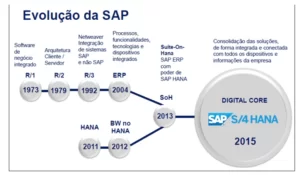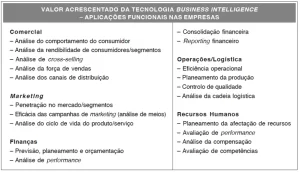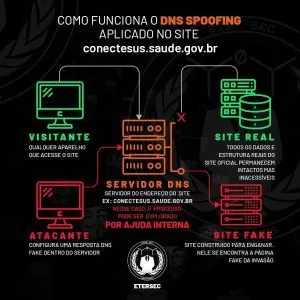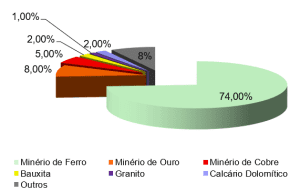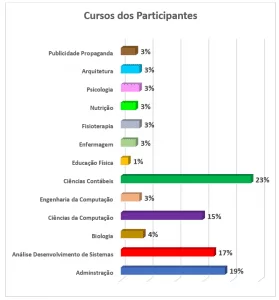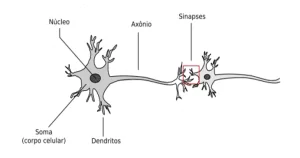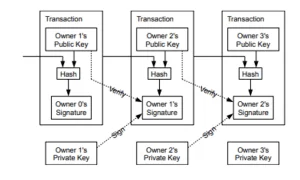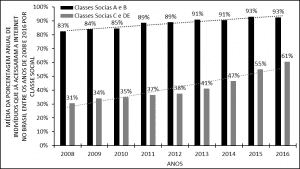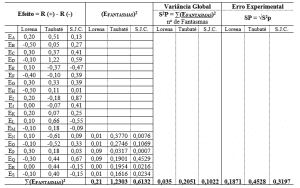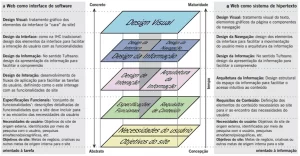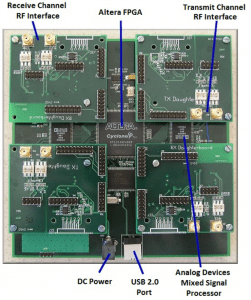FONTÃO, Henio [1], LOPES, Eloisa de Moura [2]
FONTÃO, Henio; LOPES, Eloisa de Moura. The impact of the Expertise of the leaders in information technology Governance. Multidisciplinary Core scientific journal of knowledge. 03 year, Ed. 05, vol. 01, pp. 21-35, may 2018. ISSN:2448-0959
Summary
The objective of this research was to verify the significance of certain factors inherent to the expertise of the leading information technology (it) for organizations to achieve best practice with the governance of information technology-TI. The method was the experimental, inferential statistics, and quantitative and qualitative analysis. The informants were leaders of a universe of 100 companies operating in Brazil. The data collection tool was a questionnaire with structured closed questions. The valuation of the responses meet the canons and levels of maturity in governance, founded in the manual "COBIT". Using design of experiments techniques, through an array of Plackett-Burman N = 8. As a form of supplementary analysis, the results obtained were compared with the profile of the leader you of companies, with reference to the higher levels of maturity in governance. The results showed that the expertise of the it leaders, delimited to the formation, professional experience, academic pay grade and time investment in training do not have significance for companies to reach maturity and best practices in it governance.
Keywords: governance, Expertise of it leaders, COBIT, design of experiments.
Introduction
This research studied the Governance of information technology (it), focusing on the expertise of leading you to a hundred companies operating in Brazil. This theme was chosen because, in this age of information is increasingly relevant to the use of information technologies. You enables organizations to align their strategies and receive structured data for managerial decision making and, consequently, to the achievement of business objectives. In this way, study leader profile, you can reveal whether factors such as: training, professional experience, academic pay grade and time investment in training are significant for companies to achieve governance best practices of you.
The term governance is defined as a structure of relationships and processes to divert and control organizations, in order, to achieve goals of adding value to the business, through the balanced management of risk and return on investment in (SYMONS, 2009).
To structure the processes that lead to best practices in governance, ITGI (2005) suggests the Control Objectives for Information and Related Technology (COBIT) that is a manual that proposes the measurement best practices in governance, through levels of maturity. The COBIT emphasizes that governance depends directly on the leader organization, because it is he who will support to the senior management make the it investment, guiding how the organization can be structured to achieve their business objectives (ITGI, 2009).
Weill, Ross (2006) describe, who can explain empirically it governance are administrators in charge of leadership. Nice et al. (2006); McLean; Smits; Tanner (1996); Garcia et al. (2009) and Mosque (2009) highlight the importance of certain variables relating to profiles of it leaders for management. According to these authors, these variables can be: pay grade, professional experience, education and training. Based on this hypothesis, is the problem of the survey, the same sought to verify that the profile of the leader of YOU, really, has significance for best practices in governance.
Therefore, the overall objective of this study is to verify the influence of certain variables inherent to it leaders for organizations to achieve best practices in it governance. The specific objectives are: to measure the levels of maturity in governance, from the vision of it leaders from companies operating in Brazil and, identify the profile of the it leaders that are relevant for the governance, comparing the results with a standard predefined by the COBIT it leader.
Dimensions researched and analyzed
To study governance, focusing on the profile of the it leaders in Brazilian companies, sought to first meet the concepts relating to governance and the profiles of it leaders. To this end, the description of the profile of the leader in YOU can reveal which factors influence business best practices. To this end, we used levels of maturity in governance, according to COBIT, and Brazilian business leaders as a space of analysis and informants. Within this context he elaborated the conceptual model for this research represented in Figure 01.

Corporate governance
It governance leads in corporate governance, which is defined as the creation of structures that determine the organizational objectives and monitor performance to ensure the achievement of these goals (OECD, 2009).
The Organisation for Economic Cooperation and Development-OECD (2009) States that a good corporate governance should provide incentives to managers in order to pursue objectives consistent with the interests of the company and its shareholders, and facilitate effective monitoring in order to encourage companies to use their resources more efficiently.
In business, it is the responsibility of the governance Council supervisor responsible for the protection and rights of shareholders and other stakeholders, working with a team of senior management in order to implement principles of governance to ensure the efficiency of the processes (organizational WEILL; ROSS, 2006). The management of the Council establish strategic directions, aiming to fit horizons, seize the opportunities relating to the selection and implementation of projects and studies aimed at the expansion of the company. Companies that wish to compete globally should establish efficient corporate governance systems (RAO; Mendes, 2004).
Still, according to Rodrigues; Mendes (2004), good corporate governance requires that the Council restrict to strategic issues, which should be formed by professionals with experience in strategic business management, macrorrelacionamentos, knowledge of the macroeconomic environment and business sector trends. The role of governance is to provide information that will sustain the company in its controls, processes, procedures and metrics.
It governance
Weill; Ross (2004; 2006) clarify that it governance is responsible for defining the rights and responsibilities structure decision-making to encourage desirable behavior in the use of it in business. Such governance that will determine who makes the decisions, such as who decides on how and where the company will invest in you.
By the behavioral aspect, that incorporate cultural beliefs and other elements of the Organization, defined and represented through strategies, declarations of the corporate values, mission statement and business principles, rituals and the company structures, governance defines the formal and informal relationships giving decision-making rights to individuals or groups of individuals; While, the normative side undertake to define mechanisms, formalizing the relationships and establishing rules and operational procedures and ensuring that the goals are achieved (WEILL; ROSS, 2006).
Henderson; Venkatraman (1999) describe the governance as the selection and use of organizational processes to make decisions about how to obtain and deploy the resources and IT skills. Luftman et al. (2004) describe it as a structure that makes the decisions about you, that defines why such decisions are made and how they are taken.
Forrester Research1 defines governance as the process by which decisions are made on what are the investments you, including how decisions are made, who is responsible and how the results of decisions are measured and monitored (SYMONS, 2009 ).
According to Guldentops (2004), the governance has as premise, protect the value of stakeholders; make it clear that it risks are quantified and mitigated and to direct and control the it investments. According to the author, is a generator of opportunities and benefits, brings better understanding on risk analysis; aligns it with the business, while, accepts you as a critical input to strategic planning; claims operations, prepares the Organization for the future and is an integral part of the overall corporate governance structure.
Weill; Ross (2006) point out the difficulty of explaining the governance, and they say, who can explain it empirically are administrators in charge of leadership, but few describe with precision. The authors propose a structure for the purpose of seeking understanding, to design, communicate and support effective governance.
Symons (2009) suggests a sequential and structured implementation process so that the governance reaches your effectiveness and ensure the support of senior management; develop the governance structure, including the participation of the CIO in the senior management level to strategic processes; develop processes and align existing standards processes. The goal is to integrate appropriate procedures with the culture of the organization.
It is in this context, characterized by the fact of the companies seek greater competitiveness in an increasingly digitized world, that there is a greater demand for corporate governance practices, that governance becomes a critical element to give support the survival and growth of the company.
Best practices in it governance
Best practice is a management idea which asserts that there are techniques, methods, processes, activities, incentives or rewards that are effective and efficient when you deliver a particular result. In this way, projects can be started and finished with fewer problems and unforeseen complications. According to The IT Service Management Forum, (2006), best practices are the starting point and not the goal; are recommendations, not regulations; promote a reorientation; are generic and platform-independent and is the Foundation for a more professional environment.
The role and responsibility of the it area in business support and as a resource key global enterprises organizational require a high level of quality and competence of the it organization. Is of fundamental importance for these companies adopt world-class standards of governance and management, such as: COBIT, Val IT, ITIL, ISO 17799, CMM/CMMi, PMBOK, SLM/SLA, BSC, among several others available. These methodologies and benchmarks should be used and deployed in accordance with the priorities established in the strategic plan for YOU and should reflect the business priorities of the organization.
This research used the COBIT governance pattern to define best practices.
COBIT-aspects of governance best practices
The COBIT (Control Objectives for Information and Related Technology) is a document that presents a structure focused on management. The COBIT provides good practice through a structure based on domains and processes and presents activities in a logical and manageable framework. Provides also a generic case management model that represents all processes typically found in it functions, providing a reference model understandable for operational managers of it and business (ITGI, 2005).
The COBIT consists of a set of 318 controls, organized into 34 processes and that are grouped into 4 areas. COBIT components are used to make you be oriented to business goals and to fulfil your role in that Organization (ITGI, 2005). For both, the COBIT management methodologies are organized in processes, each aiming at a target control.
The metotologia COBIT helps the business, once, through the analysis of maturity of the it processes, ensures that the same stay aligned to the business, driving it and maximizing its benefits; still, ensuring that it resources are used responsibly and the risks being managed in a proper way (ITGI, 2005).
The capacity, performance and governance define the dimensions of maturity of a process, causing companies to reduce risks and aligns business objectives. (ITGI, 2005).
The maturity model is a way of measuring how well developed processes are. Improve the maturity reduces risk and improves efficiency, leads to the reduction of errors, the more predictable processes and use resources more efficiently, in relation to the cost.
The maturity models are used to manage and control the it processes based on a method of evaluation of the Organization, in order to assess levels of non-existence (0) to optimized (5). The goal of these evaluations is to check the problems and set priorities for improvement (ITGI, 2005).
As the COBIT is based on harmonisation of existing standards of you and best practices, then, are designed to be complementary and be used in an implementation of it governance, together with another standard or set of best practices. The COBIT is oriented towards the objectives and scope of governance, ensuring that your control structure is supportive and aligned with the principles of corporate governance, meeting the demands of the Chief officers ' departments, managements (Executive, business and it), In addition to auditors and regulators (ITGI, 2005).
Profile of the it leaders
For Smircich; Morgan (1997) actions and statements of the leaders is forming action, so that in any context that are entered are able to use this sense as a point of reference for your own action and understanding of the situation, being one of the greatest challenges , managing the sense of form to lead yourself and achieve the desired purposes.
So, are born leaders able to leverage change and bring positive results for the organization. Is this profile that fits the leader of YOU, able to propose and implement projects in the competitive environment and changes, peculiar to the area in which it operates.
CIOs are being asked to lead changes in corporations, while, in time, many try to convert old infrastructure and inflexible for modern and flexible. They are being responsible for establishing global standards in applications and processes, but, sometimes, without the organizational authority to deploy these new standards. In addition, in various parts of the world, CIO's are in the battle to end the perception that YOU and all the people who make up the team are cost centers rather than creators of value and innovation accelerators (EVANS, 2009).
Methods
The experimental method, inferential statistics, and quantitative analysis.
Population
Were a hundred companies operating in Brazil that have YOU and are managed by CIO's.
Sample
The experimental sample was of eight different companies, one of the 100 companies surveyed, which were represented by their leaders (informants). The sample selected served to make observational trials, which correspond to the experiments, in situations where the variables are controlled by the researcher.
Selection of subjects and informants ' profile
The selection of the subject came about through the applied research in the 100 companies studied. However, for the selection of an array N = 8 Plackett-Burman, among these 100 companies, only those that match the structure of the matrix proposal, considering the following factors: academic training, professional experience, track and while investing in training. As for the profile of the informants were selected socio-economic factors, such as level of education and academic training.
Therefore, eight were defined it leaders with specific profiles (table 01).
Table 01 – Profile of Informants (leaders).
| Informant | Academic training | Professional experience | Pay grade/year | While investing in training |
| 1 | Graduated (computer science) | Until 16 years | Up to 200,000 | Over 50 h/a |
| 2 | Post graduate | Until 16 years | Up to 200,000 | Up to 50 h/a |
| 3 | Post graduate | Over 16 years | Up to 200,000 | Up to 50 h/a |
| 4 | Graduated (Administration) | Over 16 years | Above 200,000 | Up to 50 h/a |
| 5 | Post graduate | Until 16 years | Above 200,000 | Over 50 h/a |
| 6 | Graduated (Administration) | Over 16 years | Up to 200,000 | Over 50 h/a |
| 7 | Graduate (Engineering) | Until 16 years | Above 200,000 | Up to 50 h/a |
| 8 | Post graduate | Over 16 years | Above 200,000 | Over 50 h/a |
Source: prepared by the authors.
Authors such as Beautiful; Son; Sandhu; Silva, (2006) and McLean; Smits; Tanner (1996), researched about the pay grade of those professional, while authors such as Garcia; et al. (2009) studied the experience of it leaders. Already, Mosque (2009), as well as professional experience, researched about the academic training and training involved in the profession of managers and it leaders.
Data collection
The data collection instrument was a structured questionnaire with closed questions applied to it leaders.
The measurement of responses followed the methodology proposed by ISACA (2006) and ITGI (2009), i.e. the COBIT, which suggests six numeric maturity levels (0, 1, 2, 3, 4 and 5) for assessment of best practices in governance, namely: (0 = processes are non-existent); (1 = initial processes or even disorganized); (2 = processes follow a standard model of execution); (= 3 processes are fully documented and disseminated); (4 = processes are monitored and measured); (5 = best practices are automated measures).
The it leaders of the hundred companies bounded as a space of analysis and, based on the six levels of the COBIT maturity, will be valued it processes, grouped in five blocks: overview of it in the enterprise; alignment of it to business; it services management; quality of services and the governance and delivery of services.
The questions of the questionnaire for data collection and the five blocks used in this research were based and adapted the model suggested by ITGI (2009), which recommends that the study on 34 cases, grouped into four areas.
To ensure with 95% confidence, assertiveness and the quality of the answers, applied statistical experiments inferenciais. Thus, observational trials were conducted on the data to verify whether the expertise of leaders are significant for companies to have best practices in governance.
Selection of independent variables
Four independent variables were selected: academic training, work experience, pay grade and time investment in training.
Selection of levels of control variables
Through the results obtained in the research applied two segmented groups of often and has set itself two levels ("+") and ("-") for each of the independent variables, as the experimental model, picture 02.
02 frame-independent variables and levels of control.
| Factors | Level | |||
| High (+) | Low (-) | |||
| 1 | The | Academic training. | Graduated. | Post graduate. |
| 2 | (B) | Professional experience. | Up to 16 years. | Over 16 years. |
| 3 | (C) | Pay grade. | Up to 200,000 | Over 200,000 |
| 4 | (D) | While investing in training. | Up to 50 h/a. | Over 50 h/a. |
Source: prepared by the authors.
Selection of experimental array ("observational")
The Plackett-Burman method, N = 8 (table 03), because, according to Barros Neto et al., (2003) this technique is recommended to meet the need for research in exploratory situations and with cost optimization and refinement of processes. The array N = 8, because the data available allowed just this combination.
According to Barros Neto et al. (2003) and Montgomery (2004), the experimental method saturated fractional factorial Plackett-Burman, lets look into N-1 factors, besides the use of inert or "ghosted" columns, which are used to make the estimate of experimental error. Following this method, devised an experimental (observational) arrangement with seven factors (N = 8-1), four real variables with two levels of control ("+") and ("-") and three ghosts, picture 04.
Frame 03 – experimental Array.
| Experiments (Comments) | The | (B) | (C) | (D) | And | (F) | G |
| 01 | + | + | + | – | + | – | – |
| 02 | – | + | + | + | – | + | – |
| 03 | – | – | + | + | + | – | + |
| 04 | + | – | – | + | + | + | – |
| 05 | – | + | – | – | + | + | + |
| 06 | + | – | + | – | – | + | + |
| 07 | + | + | – | + | – | – | + |
| 08 | – | – | – | – | – | – | – |
Source: adapted from Engineering Statistics Handbook (2007); Plackett; Burman (1946).
The experimental array, for having orthogonal columns allows the selected factors are investigated, so that there is a symmetrical study established levels. In this sense, the combination of the two different levels of each factor is selected that defines the profile of the informants.
04-frame arrangement of the independent variables.
| Factors | Level | |||
| High (+) | Low (-) | |||
| 1 | The | Academic training. | Graduated. | Post graduate. |
| 2 | (B) | Professional experience. | Up to 16 years. | Over 16 years. |
| 3 | (C) | Pay grade. | Up to 200,000 | Over 200,000 |
| 4 | (D) | While investing in training. | Up to 50 h/a. | Over 50 h/a. |
| 5 | And | Ghost. | ||
| 6 | (F) | Ghost. | ||
| 7 | G | Ghost. | ||
Source: prepared by the authors.
Through the array N = 8, the data were processed directly and the variables related to the object of study.
Selection of the dependent variable or reply
Bonduelle S.a. (2000) proposes and Vergara (2000), the experimental method consists of an empirical research, in which submit the study to the influence of the independent variables to observe the results in dependent variables and help decision-making. In this regard, it was found the influence of factors related to the expertise of the it leaders (independent variables) in a dependent variable (level of maturity in governance), as the Table 05.
Frame 05-isolated process for study.
| Independent variables (X ´ s) | The Dependent Variable (Y) | ||||
| Factors | Level | Level of maturity in governance | |||
| High (+) | Low (-) | ||||
| 1 | The | Academic training. | Graduated. | Post graduate. | |
| 2 | (B) | Professional experience. | Up to 16 years. | Over 16 years. | |
| 3 | (C) | Pay grade. | Up to 200,000. | Over 200,000. | |
| 4 | (D) | While investing in training. | Up to 50 h/a. | Over 50 h/a. | |
| 5 | And | Ghost. | |||
| 6 | (F) | Ghost. | |||
| 7 | G | Ghost. | |||
Source: authors.
The symmetry and the orthogonality of the experimental model used allowed the eight experiments (comments) represent sixteen/business leaders, in the context of a factor analysis with two levels of control and four real factors, i.e., 24 = 16.
Frame 06 – scale of measurement, as manual "COBIT".
| Answer the questions taking care as the six maturity levels: · 0 = non-existent processes; · 1 = initial processes or disorganized; · 2 = processes follow a standard model of execution; · 3 = processes are fully documented and disseminated; · 4 = processes are monitored and measured; · 5 = best practices are measures and automated. |
Source: prepared by the authors.
The valuation of the responses meet the canons and levels of maturity in governance, founded in the manual "COBIT", picture 06.
Analysis of the data
The data was quantitatively through statistical procedures. It was used within the Group of parametric statistical tests, Student's t test to observe the distribution of the variables. The data processing was done through Excel calculations worksheet for Windows XP computer package from Microsoft.
Results and discussion
The measurement of responses through the sum of the values assigned by informants. We present the responses of the eight informers (each one of the informants representing your respective company) used as a sample in observational trials, as the graphics 01 02 03, 04, and 05,. Each answer of question was valued from 0 to 5, according to the COBIT maturity levels.
The values of the graph correspond to 01 sum of values assigned by it leaders to 48 questions concerning overview of YOU in business.
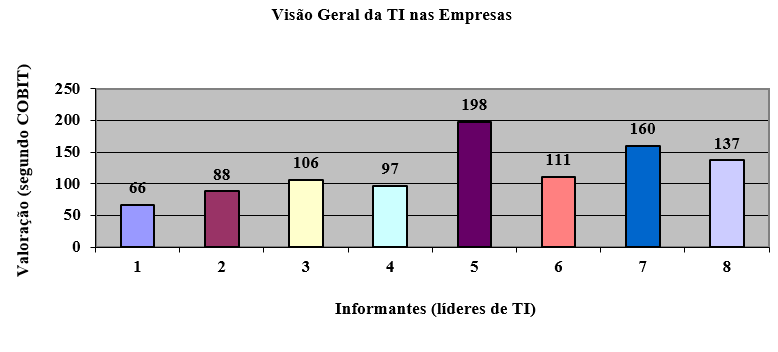
The values of the graph correspond to 02 sum of values assigned by it leaders to 17 questions relating to management of it services.
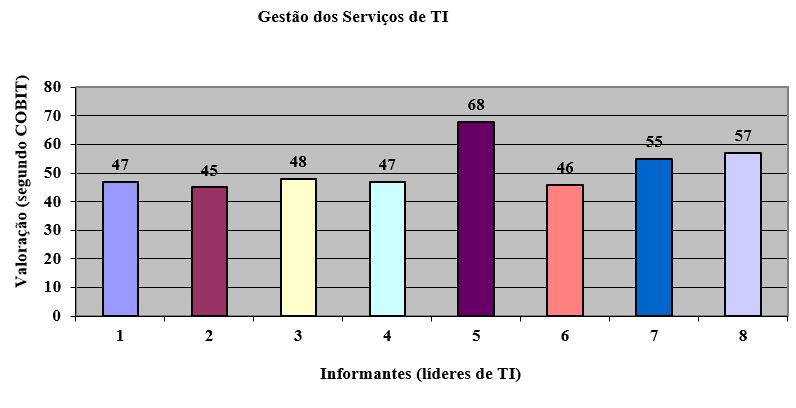
The values of the graph correspond to 03 sum of values assigned by it leaders for 20 questions relating to quality of services and governance.
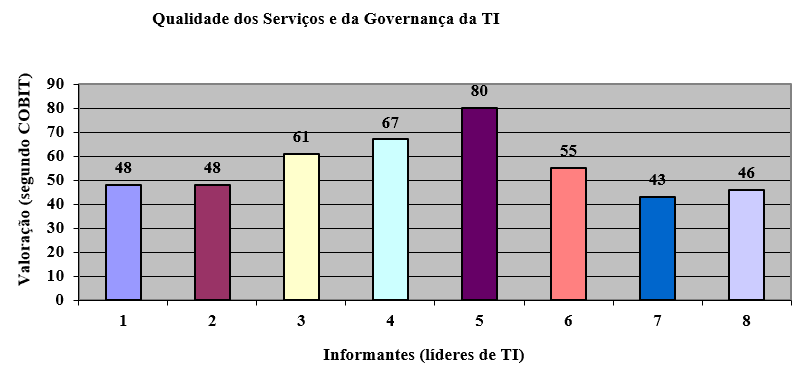
The values of the graph correspond to 04 sum of values assigned by it leaders for 27 questions relating to the delivery of it services.
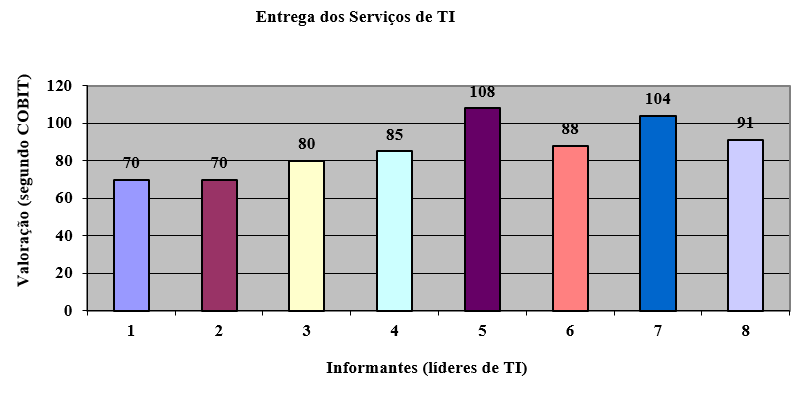
The values of the graph correspond to 05 sum of values assigned by it leaders for 30 questions referring to the alignment of it to business.
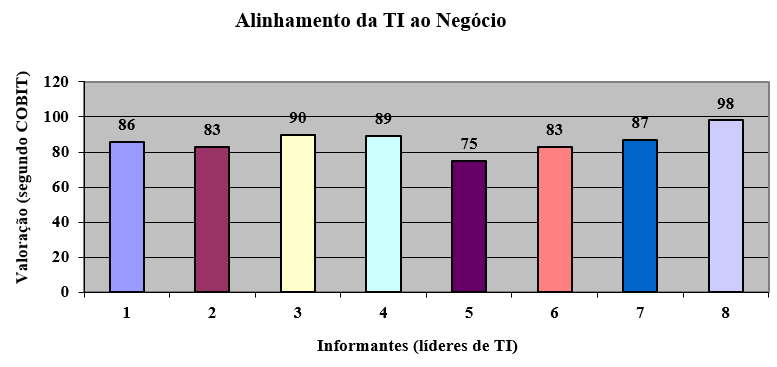
The values of the graph 06 correspond to sum of the values assigned by it leaders for the five blocks: overview, it service management, service quality of it governance, it service delivery, and alignment of it to business. These blocks, once compiled, define the level of maturity in governance.
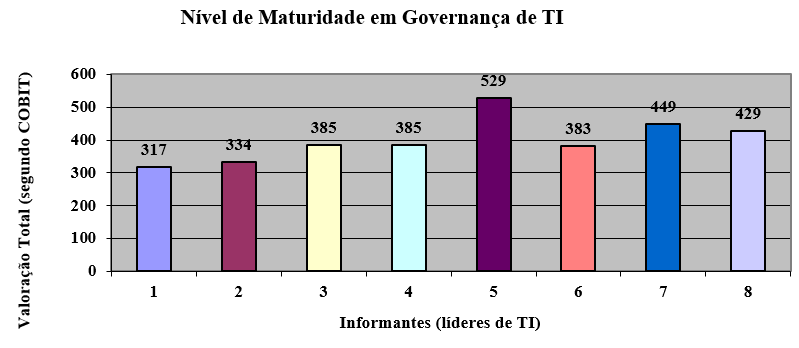
The 07 Frame demonstrates the respective replies of the experiments performed with relation to profiles of the informants defined by experimental (observational) array.
Frame 07-experimental Array and replies of the informants, according to valuation by COBIT maturity levels.
| Experiments | The | (B) | (C) | (D) | And | (F) | G | Reply |
| 01 | + | + | + | – | + | – | – | 317 |
| 02 | – | + | + | + | – | + | – | 334 |
| 03 | – | – | + | + | + | – | + | 385 |
| 04 | + | – | – | + | + | + | – | 385 |
| 05 | – | + | – | – | + | + | + | 529 |
| 06 | + | – | + | – | – | + | + | 383 |
| 07 | + | + | – | + | – | – | + | 449 |
| 08 | – | – | – | – | – | – | – | 429 |
Source: prepared by the authors.
The calculations were repeated in each combination of levels, represented by selected factors, hence have the effects of the factors represented by the letters "A" to "G", as Table 08.
Picture 08-Calculation of the effects of the factors, global variance, experimental error.
| Effect = R (+)-R (-) | (EFANTASMAS) 2 | Global Variance | Experimental Error | ||
| S2P = 8 (EFANTASMAS) 2no ghosts | SP = √ S2p | ||||
| And | -35.75 | 1708.3958 | 41.3327 | ||
| EB | 11.75 | ||||
| EC | -93.25 | ||||
| ED | -26.25 | ||||
| EE | 5.25 | Ghost | 27.5625 | ||
| EF | 12.75 | Ghost | 162.5625 | ||
| EG | 70.25 | Ghost | 4935.0625 | ||
| Projector (EFANTASMAS) 2 | 5125.1875 | ||||
Source: prepared by the authors.
Through the values of the experimental errors, calculated values of "t" or "t" calculated, which were subsequently compared to the value of the "t critical" model "Student's t, obtained through the Critical Values table of Student's t and thus Consequently defined the significance of the factors studied, as shown in table 09.
For significance testing, if the "t" factor calculated is greater than or equal to "t critical", then, has been the factor in question significant in the process with a degree of confidence equal to or greater than 95%. On the other hand, if the "t" is less than the calculated "t critical", then the factor studied does not have significance in the process. Thus, the processed data showed the significance of the effects of factors on the dependent variable.
09-frame Test of significance.
| t Calculated | t Critic | Results of significance tests | ||
| tcalc the | 0.86 | < | 3.182 | NOT SIGNIFICANT |
| tcalc B | 0.28 | < | 3.182 | NOT SIGNIFICANT |
| tcalc C | 2.26 | < | 3.182 | NOT SIGNIFICANT |
| tcalc D | 0.64 | < | 3.182 | NOT SIGNIFICANT |
| tcalc and | 0.13 | < | 3.182 | NOT SIGNIFICANT |
| tcalc F | 0.31 | < | 3.182 | NOT SIGNIFICANT |
| tcalc G | 1.70 | < | 3.182 | NOT SIGNIFICANT |
Source: prepared by the authors.
The results obtained show that the factors selected and studied do not have significance to the isolated in this survey process, i.e. the expertise of leaders selected are not significant for that companies surveyed have a tendency to possess best practices in governance.
Particularly in this research, one must consider the possibility that specific profiles of it leaders are not actually important to the best practices of it governance. In this sense, companies must use their peculiar institutional criteria for selection of these professionals. The results on non-significant effects also led to questions about the possibility of the leaders of the sample have significance in other managerial processes important to organizations. Also, one can realize that in the case of levels of control of the "academic", i.e. "graduate or postgraduate", no significance for the process is independent of the degree of the informants, whereas the experimental sample included professional graduates in computer science, engineering and business administration.
Ch; Silva (2006) state that the fixed remuneration works generally as toilet and factor can't motivate employees to improve activities. In this line of reasoning, the survey results showed that even the total annual wage factor does not possess significance for best practices in governance.
Whereas the design of experiments is a mechanism that helps the decision making, second (FONTÃO, 2008); so, this tool can also be used in other structural processes of governance, because, according to Luftman; et al. (2004), the governance must define why and how decisions are made.
Final Considerations
The problem with this research is based on the importance of knowing it leaders profiles that help companies to achieve best practices in it governance. In this way, the objective was to verify the significance of certain factors inherent to the profile of it leaders for organizations to have best practices in governance. Yes, it was believed that select the Professional with profile that will add value to the processes of maturity in governance, can help companies avoid waste and minimize costs.
In this sense, it is believed that the answers found attended the methodological proposals of research, because, through the application of an exploratory tool, optimization and refinement, researchers are able to identify the profile of the leader of yourself that can contribute to best practices in governance.
The results showed that none selected factor has no significance for the process studied, however, in view of this fact and of the limitations of the method applied, could raise possible opportunities and considerations for future jobs give continuity to this research, such as: check the significance of other factors and levels of control inherent in the profile of it leaders for the process of best practice in governance; consider the diversity among the companies, the segments and the regions demarcated for a survey of this nature.
References
BARROS NETO, B.; SCARMÍNIO, I.S.; BRUNS, R.E. As experiment research and development in science and industry. Campinas: Universidade Estadual de Campinas, 2003. 401 p.
BEAUTIFUL, ALREADY. C. S.; SON, J. G. A. T.; SANDHU, A. P. C.; SILVA, m. m. Aspects involving the professional profile of is/it and your hierarchical level and decision-making in the Organization-an exploratory study on the Recife metropolitan region. XXVI ENEGEP-Fortress, 2006.
BONDUELLE S.A., g. m. application of design of experiments to control the manufacture of wooden fibres. UFPR. 2000.
CARVALHO, M. A.; SCOTT, B. V. M. The motivation for work focusing on the financial aspect. XIII SIMPEP – Bauru, 2006.
ENGINEERING STATISTICS HANDBOOK. Available at: http://www.itl.nist.gov/div898/handbook/pri/section3/pri335.htm. Access in: 07 jan. 2007.
EVANS, b. Leaders are changing the business world. The information Week. Available at: http://www.itweb.com.br. Access in: 20 jul 2009.
FONTAO, h. design of experiments: application of a Lean Six Sigma Tool for enterprise management in small Grocery retailers. Taubaté: UNITAU, 2008. 110 p. Dissertation (master)-graduate program of the Department of Economics, accounting and business administration, University of Taubaté, Taubate, 2008.
GIL, Bc As elaborate research projects. São Paulo: Atlas, 1996. 159p.
GARCIA, F. R. F.; LO DUCA, A.; OLIVEIRA, H.; OLIVEIRA, P. A. G.; RAMALHO, b. a. profile of the it Manager – an analysis of the new administrator. Available at: www.ead.fea.usp.br/Semead/10semead/sistema/resultado/…/86.pdf. Access in: 05 Aug. 2009.
GREMBERGEN, W. V., DE HAES, s., GULDENTOPS, e. Structures, process the relational mechanisms for information technology governance: theories an practices. In: VAN GREMBERGEN, w. Strategies for information technology governance, Hershey: Idea group publishing, 2004.
HENDERSON, J. C.; VENKATRAMAN, n. Strategic alignment: Leveraging information technology for transforming organizations. IBM Systems Journal, 1999.
ISACA-Information System Audit & Control Association. Is standards, guidelines and procedures for auditing and control professionals. Illinois: ISACA, 2006.
ITGI. COBIT 4.0: Control Objectives, Management Guidelines, Maturity Models. It Governance Institute. Rolling Meadows, IL, Usa. 2005.
ITGI, IT Governance Institute. Board Briefing on IT Governance. 2nd Edition. Information Technology Governance Institute. Available at http://www.itgi.org. 2009.
ITMSF. The IT service management Forum. Brazil, 2006. ITSMFUSA, An Introductory Overview of ITIL ® V3. Version 1.0. It Service Management: An Introduction. The UK Chapter of the itSMF, 2009.
LUFTMAN, J. N.; LEWIS, P. R.; OLDACH, s. h. Transforming the enterprise: The alignment of business and information technology strategies. IBM System Journal, 1993, v. 32, n. 1, p. 198-220.
Mclean, E. R.; SMITS, N. I.; TANNER, j. r. Importance of salary on job and career attitudes of information systems professionals. Information Management vol. 30 &: p. 291-299.1996.
MARSH, r. who they are and what they think the it leaders. São Paulo: Career-Electronic Magazine, Publisher: IDG Brazil Limited. Available at: http://cio.uol.com.br/2005/08/career/23/idgnoticia. 8/23/2005.1669013482/. Access in: 05 Aug. 2009.
MONTGOMERY, d. c. Introduction to statistical quality control. Rio de Janeiro: LTC, 2004.
OECD. Organisation for Economic Co-operation and Development. Available at: <http: www.oecd.org="">accessed on 2009.</http:>
PLACKETT, R.L.; BURMAN, J.P. The design of optimum multifactorial experiments. Biometrika, 1946. p. 305-325.
RAO, J. A.; Mendes, g. m. Corporate Governance: strategy for value creation. Rio de Janeiro: Thorsons, 2004.
SMIRCICH, L.; MORGAN, g. leadership: the directors of sense. In: BERGAMINI, C. W.; CODA, r. Psychodynamics of organizational life: motivation and leadership. São Paulo: Atlas, 1997.
SYMONS, c. IT Governance and the Balanced Scorecard. Forrester Research. Available in <http: www.forrester.com="">2009.</http:>
SYMONS, c. IT Governance Framework, Structure, Process and Communication. Forrester Research. Available in <http: www.forrester.com="">2009.</http:>
SYMONS, c. Trends in IT performance management. 2005. Available at: http://www.forrester.com./research/document/excerpt. Access in: 21 jul 2009.
VERGARA, S.C. projects and research reports in business administration. São Paulo: Atlas, 2000. 92 p.
WEILL, P.; ROSS, j. w. IT Governance – How Top Performers Manage IT Decision Rights for Superior Results. Harvard Business School Press. Boston, Massachusetts, USA, 2004.
WEILL, P.; ROSS, j. w. governance, information technology. São Paulo: m. Books of Brazil, 2006.
[1] Faculty of Technology of Pindamonhangaba; Centre for research in economic and Sociology of organizations, Lisbon, Portugal
[2] Faculty of Technology of Pindamonhangaba

